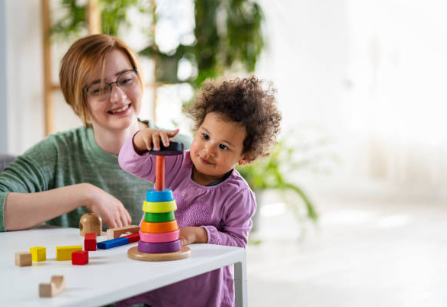Bite No More: Proven Tips to Stop Toddler Biting
Biting is a common behavior among toddlers, but that doesn’t make it any less frustrating! However, t’s important to understand that kids use behavior to communicate. When a 2-year-old bites their sibling, it’s often because they can’t express themselves in other ways, like wanting a toy. At first, biting might seem effective for getting what they want, it’s not the healthiest option. With patience and guidance, we can help them learn better ways to communicate.
Why Do Toddlers Bite?
Biting can stem from various reasons, including:
- Inability to communicate needs or emotions
- Oral sensory exploration (teething)
- Mimicking others
- Frustration, anger, or other big emotions
To address the behavior effectively, the first step is observing when and why your child bites. Keeping a note in your phone or a journal about the circumstances of each incident can help you spot patterns and address the root cause.

Strategies for Curbing Biting Behaviors
- The Knotted Bandana Redirect
A simple and effective tool is a knotted bandana. Here’s how it works:
- Let your child choose a bandana each morning and tie it around their wrist with a double knot.
- Teach them that it’s okay to bite the knot on their wrist when they feel the urge.
- If your child bites someone, remind them that we don’t bite people and redirect them to bite the bandana instead.
This method helps redirect the biting action into a safer, more acceptable outlet.
- Focus on the Victim
When a biting incident occurs, avoid giving too much attention to the behavior itself. Instead, focus on the child who was bitten. Offer comfort and have your child help if possible. Afterward, discuss alternatives to biting with your child, like using words such as “no,” “stop,” or “that’s mine.” The goal is to teach them to express themselves verbally rather than through biting.
- Build Emotional Literacy
Many times, biting comes from frustration or strong emotions that toddlers can’t express. Therefore, use these opportunities as teaching moments to build emotional literacy. After an incident, help your child identify the emotion they were feeling, such as anger or frustration. Talk through how they could have handled the situation differently.
Additionally, books are a great resource for teaching emotional literacy. Some helpful books include:
- “Teeth Are Not for Biting” by Elizabeth Verdick
- “No Biting!” by Karen Katz (with a free activity guide)
- Sensory Exploration
Sometimes, children bite due to sensory exploration needs, especially when teething. You can support healthy exploration by offering safe alternatives for mouth-related activities. Here are a few ideas:
- For starters, provide foods with varying textures, like crunchy fruits or veggies.
- Next, play with sensory toys like playdough or putty.
- Additionally, create sensory bags filled with materials like paint or hair gel that your child can squish and manipulate.
- Finally, make sensory bins filled with sand, oatmeal, or soapy water and let your child explore with their hands.
Conclusion
While biting can be a frustrating phase, with patience and consistency, your child can learn more appropriate ways to communicate their feelings. By redirecting the behavior, building emotional literacy, and providing safe outlets for sensory exploration, you’re helping your child develop the skills they need to manage their emotions in healthier ways. Remember, this phase will pass, and with time, your child will have learned more positive ways to express themselves!




